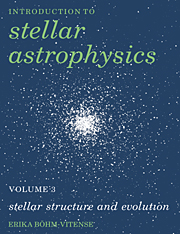Book contents
- Frontmatter
- Contents
- Preface
- 1 Introduction
- 2 Hydrostatic equilibrium
- 3 Thermal equilibrium
- 4 The opacities
- 5 Convective instability
- 6 Theory of convective energy transport
- 7 Depths of the outer convection zones
- 8 Energy generation in stars
- 9 Basic stellar structure equations
- 10 Homologous stars in radiative equilibrium
- 11 Influence of convection zones on stellar structure
- 12 Calculation of stellar models
- 13 Models for main sequence stars
- 14 Evolution of low mass stars
- 15 Evolution of massive stars
- 16 Late stages of stellar evolution
- 17 Observational tests of stellar evolution theory
- 18 Pulsating stars
- 19 The Cepheid mass problem
- 20 Star formation
- Appendix Radiative energy transport in stars
- Problems
- References
- Index
5 - Convective instability
Published online by Cambridge University Press: 08 January 2010
- Frontmatter
- Contents
- Preface
- 1 Introduction
- 2 Hydrostatic equilibrium
- 3 Thermal equilibrium
- 4 The opacities
- 5 Convective instability
- 6 Theory of convective energy transport
- 7 Depths of the outer convection zones
- 8 Energy generation in stars
- 9 Basic stellar structure equations
- 10 Homologous stars in radiative equilibrium
- 11 Influence of convection zones on stellar structure
- 12 Calculation of stellar models
- 13 Models for main sequence stars
- 14 Evolution of low mass stars
- 15 Evolution of massive stars
- 16 Late stages of stellar evolution
- 17 Observational tests of stellar evolution theory
- 18 Pulsating stars
- 19 The Cepheid mass problem
- 20 Star formation
- Appendix Radiative energy transport in stars
- Problems
- References
- Index
Summary
General discussion
So far we have talked about energy transport by radiation only. We may also have energy transport by mass motions. If these occur hot material may rise to the top, where it cools and then falls down as cold material. The net energy transport is given by the difference of the upward transported energy and the amount which is transported back down. Such mass motions are also called convection. Our first question is: when and where do these mass motions exist, or in other words where do we find instability to convection? When will a gas bubble which is accidentally displaced upwards continue to move upwards and when will a gas bubble which is accidentally displaced downwards continue to move downwards? Due to the buoyancy force a volume of gas will be carried upwards if its density is lower than the density of the surroundings and it will fall downwards if its density is larger than that of the surroundings.
From our daily experience we know that convection occurs at places of large temperature gradients, for instance over a hot asphalt street in the sunshine in the summer, or over a radiator in the winter. The hot air over the hot asphalt, heated by the absorption of solar radiation, has a lower density than the overlying or surrounding air. As soon as the hot air starts rising by an infinitesimal amount, it gets into cooler and therefore higher density surroundings and keeps rising due to the buoyancy force like a hot air balloon in the cooler surrounding air. This always occurs if a rising gas bubble is hotter than its surroundings.
Information
- Type
- Chapter
- Information
- Introduction to Stellar Astrophysics , pp. 51 - 60Publisher: Cambridge University PressPrint publication year: 1992
